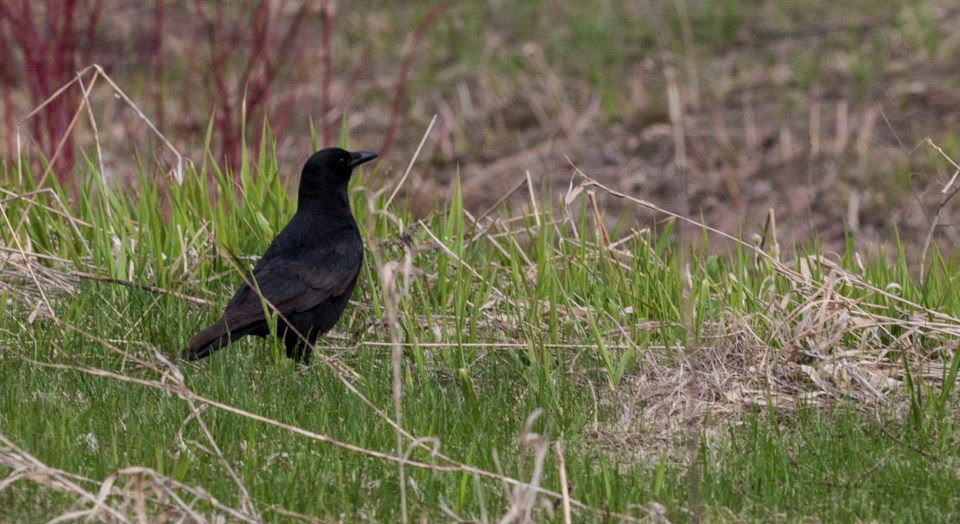While anthropomorphism is a honkin' big word, it describes something we do, probably every day. Have you ever looked at an animal and said that "it looks like it’s hungry" or "it must be lonesome" or "it acts angry?" The transfer of a human emotion onto an animal is an anthropomorphic act.
Walt Disney took this notion that we can read the minds of animals and raised it to an art form: Bambi, Dumbo, Baloo, Topper, Rafiki… the list seems endless.
And by having animals do human behaviours, such as the spaghetti dinner shared by Lady and her trampish beau, we are drawn further into the belief that we "know" what goes on inside an animal's head.
I wonder if ol' Walt ever dreamed of the impact his work would have on our society. It is nigh impossible to view the activities around a bird feeder without slipping into some level of emotional transfer: the bullying grackle, the sleazy starling, the impish chickadee.
While sneaking into town a few days ago on a grocery run, I saw a crow on the roadway, which is common enough. As I got closer, it was apparent that the crow was pecking and pulling at something laying on the road. This, too, is a common occurrence, as crows are scavengers and often dine on road killed raccoon, porcupine or skunk. Morte of the day, so to speak.
As I drove by, the scene became very clear. Laying face down on the road was a dead crow, very freshly killed (feathers still loose, body still with a shape to it). The second crow was pecking and tugging at the body, so intently so that it didn't fly up as I drove by.
Okay, what's the story here? As I mulled over what I had just seen (delighted that I had something to think about other than reports about the global pandemic), three scenarios came to mind. Was the second crow the mate of the first crow? Was he/she so overcome with grief that even an oncoming car couldn't deter it from trying to revive or pull its mate to safety? "Wake up, Bill! Please wake up!" It's a tear-jerker.
Or was the second crow taking advantage of the dead crow’s dilemma? As it stuck with sharpened beak was it thinking, "Take that ya big bully! And that! And that! Yeah, you don't act so tough now that you're dead!" And a territory dispute comes to an end.
And there's always the third choice: "Mmm, mmm. Fresh meat. Yum Yum." Crows eat young birds and eggs of other bird species, why not of their own?
Which scene is the right one? Are my transfer of emotions to the living crow correct? And if so, which is correct… sadness, defiance or satisfaction?
While talking about crows (which are in the Corvid family and not to be confused with Covid) have you noticed that crows are setting up their spring nesting territories? Sticks are being hauled into the woods from all points of the compass, and courtship flights can be noted over fields and meadows. But why is there always, okay usually, three crows?
Two crows are needed to make a pair, but what's with the third? Not always but often the group count is three. Here's my take on it… either it's a left over offspring from last year ("when will Junior ever leave us alone?"), or maybe crows don't pair up, maybe they triple up? One male and two females is not unheard of in the bird world.
When we are fortunate enough to see an event in the animal world, use some caution as to how the event becomes interpreted. Try to imagine that you have never seen a Disney movie, that what you are witnessing is open to all points of view.
Try to put yourself in the animal’s place but not with your emotions. It's a very hard thing to do. However, with some practice, maybe you'll learn to live with or at least tolerate critters such as snakes and spiders, rather than immediately assuming they are “bwa-ha-ha” evil and out to get us (or at least trying to detain us until some noble savior rides up on a white stallion).
While undergoing your COVID-inspired isolation, a study of the Facebook’s “cat vs. dog vs. human” postings are a great insight to anthropomorphism.
Do not think of this as bored scrolling, rather turn it into an in-depth study of the rationales of humans to interpret the behaviours of domesticated stock within the limited confines of an anthro constructed abode. There, feels more rewarding already, doesn’t it?
